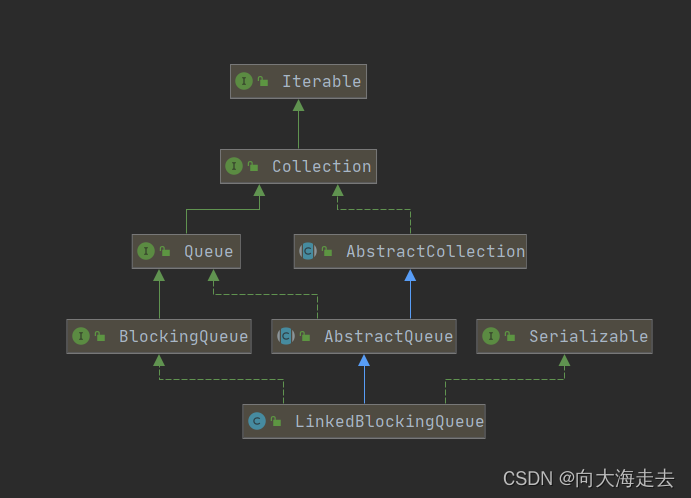LinkedBlockingQueue
接上文, LinkedBlockingQueue 实现了 BlockingQueue 接口
类图:

它的特性:
- 基于链表节点的阻塞队列
- 队列元素FIFO(先进先出)排序
- 队列的头部元素是停留时间最长的,尾部是停留时间最短的新元素,(尾部追加,头部取出)
- 链表队列比数组队列具有更高的吞吐量
- 可通过构造方法指定队列容量,默认是Integer的最大值
- 实现了
Collection和Iterator接口方法
内部构成
从 LinkedBlockingQueue 特性可知,元素添加在链表节点 ,而它的内部便维护了 链表节点类 Node
/**
* Linked list node class
*/
static class Node<E> {
E item;
/**
* One of:
* - the real successor Node
* - this Node, meaning the successor is head.next
* - null, meaning there is no successor (this is the last node)
*/
Node<E> next;
Node(E x) { item = x; }
}
- item 表示当前元素
- next 表示当前节点的下一节点,为null,则是最后一个
成员变量
/** 容量 */
private final int capacity;
/** 当前元素数量,线程安全 */
private final AtomicInteger count = new AtomicInteger();
/**
* 头部节点
*/
transient Node<E> head;
/**
* 尾部节点
*/
private transient Node<E> last;
/** 读取元素锁 */
private final ReentrantLock takeLock = new ReentrantLock();
/** 读取元素条件等待队列 */
private final Condition notEmpty = takeLock.newCondition();
/** 写入元素锁 */
private final ReentrantLock putLock = new ReentrantLock();
/** 写入元素条件等待队列 */
private final Condition notFull = putLock.newCondition();
由此可知,LinkedBlockingQueue 提供了两把锁,目的是take和put能同时进行。
构造方法
初始化一个 LinkedBlockingQueue 支持无参构造和有参构造
无参构造,默认初始化容量大小为Integer的最大值
public LinkedBlockingQueue() {
this(Integer.MAX_VALUE);
}
有参构造,可以指定容量大小,也可通过集合初始化
public LinkedBlockingQueue(int capacity) {
if (capacity <= 0) throw new IllegalArgumentException();
this.capacity = capacity;
// 头尾节点相同,都为null
last = head = new Node<E>(null);
}
public LinkedBlockingQueue(Collection<? extends E> c) {
this(Integer.MAX_VALUE);
final ReentrantLock putLock = this.putLock;
putLock.lock(); // Never contended, but necessary for visibility
try {
int n = 0;
for (E e : c) {
if (e == null)
throw new NullPointerException();
if (n == capacity)
throw new IllegalStateException("Queue full");
enqueue(new Node<E>(e));
++n;
}
count.set(n);
} finally {
putLock.unlock();
}
}
/**
* Links node at end of queue.
*
* @param node the node
*/
private void enqueue(Node<E> node) {
// assert putLock.isHeldByCurrentThread();
// assert last.next == null;
last = last.next = node;
}
- 通过putLock加锁
- 集合元素不能为null
- 队尾添加,赋值给链表的最后节点
- 赋值总的元素个数
成员方法
Put方法
public void put(E e) throws InterruptedException {
if (e == null) throw new NullPointerException();
// Note: convention in all put/take/etc is to preset local var
// holding count negative to indicate failure unless set.
// 临时变量,负数表示新增失败
int c = -1;
// 新增一个Node节点
Node<E> node = new Node<E>(e);
// 获取put锁
final ReentrantLock putLock = this.putLock;
// 当前容器元素个数
final AtomicInteger count = this.count;
// 可中断锁
putLock.lockInterruptibly();
try {
/*
* Note that count is used in wait guard even though it is
* not protected by lock. This works because count can
* only decrease at this point (all other puts are shut
* out by lock), and we (or some other waiting put) are
* signalled if it ever changes from capacity. Similarly
* for all other uses of count in other wait guards.
*/
// 如果队列满了
// 则阻塞当前线程,等待其他线程唤醒(take成功后,会唤醒此处等待的线程)
while (count.get() == capacity) {
notFull.await();
}
// 队尾添加节点
enqueue(node);
// 先获取再自增
// c 比 真实的count 小1
c = count.getAndIncrement();
// 添加完后,队列未满,则唤醒其他阻塞的put线程
if (c + 1 < capacity)
notFull.signal();
} finally {
// 释放锁
putLock.unlock();
}
// c=0,表示队列有一个元素
if (c == 0)
// 尝试唤醒阻塞的take线程
signalNotEmpty();
}
从源码中,我们可以总结几点:
- 添加元素时第一步先加锁,所以新增数据是线程安全的。
- 新增时,如果队列满了,则会阻塞当前线程。
- 队列新增,简单的追加都尾部节点即可。
- 新增元素成功后,如果队列未满,会唤醒其他阻塞的put线程,队列不为空,会唤醒其他阻塞的take线程,这样就能保证队列一旦满足put或take条件时,立马就能唤醒阻塞线程,继续运行,保证唤起的时机不被浪费。
offer方法
offer 我们重点看一下,带超时参数的方法
public boolean offer(E e, long timeout, TimeUnit unit)
throws InterruptedException {
// 同put一样,元素不能为null
if (e == null) throw new NullPointerException();
// 转换超时时间单位
long nanos = unit.toNanos(timeout);
// 预设值,负数表示添加失败
int c = -1;
// put 锁
final ReentrantLock putLock = this.putLock;
// 当前队列个数
final AtomicInteger count = this.count;
// 可中断锁
putLock.lockInterruptibly();
try {
// 当前队列个数 等于 容量,表示队列满了
while (count.get() == capacity) {
// 已过设置的超时时间
if (nanos <= 0)
// 返回添加失败
return false;
// 底层通过调用 LockSupport#parkNanos 方法阻塞当前线程
// 方法剩余时间 : deadline - 当前时间
nanos = notFull.awaitNanos(nanos);
}
// 队尾添加
enqueue(new Node<E>(e));
c = count.getAndIncrement();
if (c + 1 < capacity)
notFull.signal();
} finally {
putLock.unlock();
}
if (c == 0)
signalNotEmpty();
return true;
}
从源码,我们总结一下,offer 对比 put 方法,不同之处在于 :
- 通过调用
LockSupport#parkNanos方法睡眠当前线程,等待timeout时间之后,队列仍满,则返回false,表示新增失败。
取数据方法
取数据分为 :
- 取数据并删除 take/poll
- 只取不删除 peek
我们看一下 take 方法
public E take() throws InterruptedException {
E x;
int c = -1;
// 当前队列元素总数
final AtomicInteger count = this.count;
// take锁,可中断锁
final ReentrantLock takeLock = this.takeLock;
takeLock.lockInterruptibly();
try {
// 如果队列为空,则阻塞当前线程,等待其他线程唤醒
while (count.get() == 0) {
notEmpty.await();
}
// 从队列头部拿出一个元素
x = dequeue();
// 赋值再自增
// c 比 count 大 1
c = count.getAndDecrement();
// 取出元素成功,表示队列里面有数据
if (c > 1)
// 唤醒其他take线程
notEmpty.signal();
} finally {
takeLock.unlock();
}
// 如果队列空闲
if (c == capacity)
// 则尝试唤醒put线程
signalNotFull();
return x;
}
/**
* Removes a node from head of queue.
*
* @return the node
*/
private E dequeue() {
// assert takeLock.isHeldByCurrentThread();
// assert head.item == null;
Node<E> h = head;
Node<E> first = h.next;
h.next = h; // help GC
head = first;
E x = first.item;
// 头节点指向null,删除
first.item = null;
return x;
}
查看并不删除元素,如果队列为空,则返回null
public E peek() {
if (count.get() == 0)
return null;
final ReentrantLock takeLock = this.takeLock;
takeLock.lock();
try {
Node<E> first = head.next;
if (first == null)
return null;
else
return first.item;
} finally {
takeLock.unlock();
}
}





















 264
264











 被折叠的 条评论
为什么被折叠?
被折叠的 条评论
为什么被折叠?








